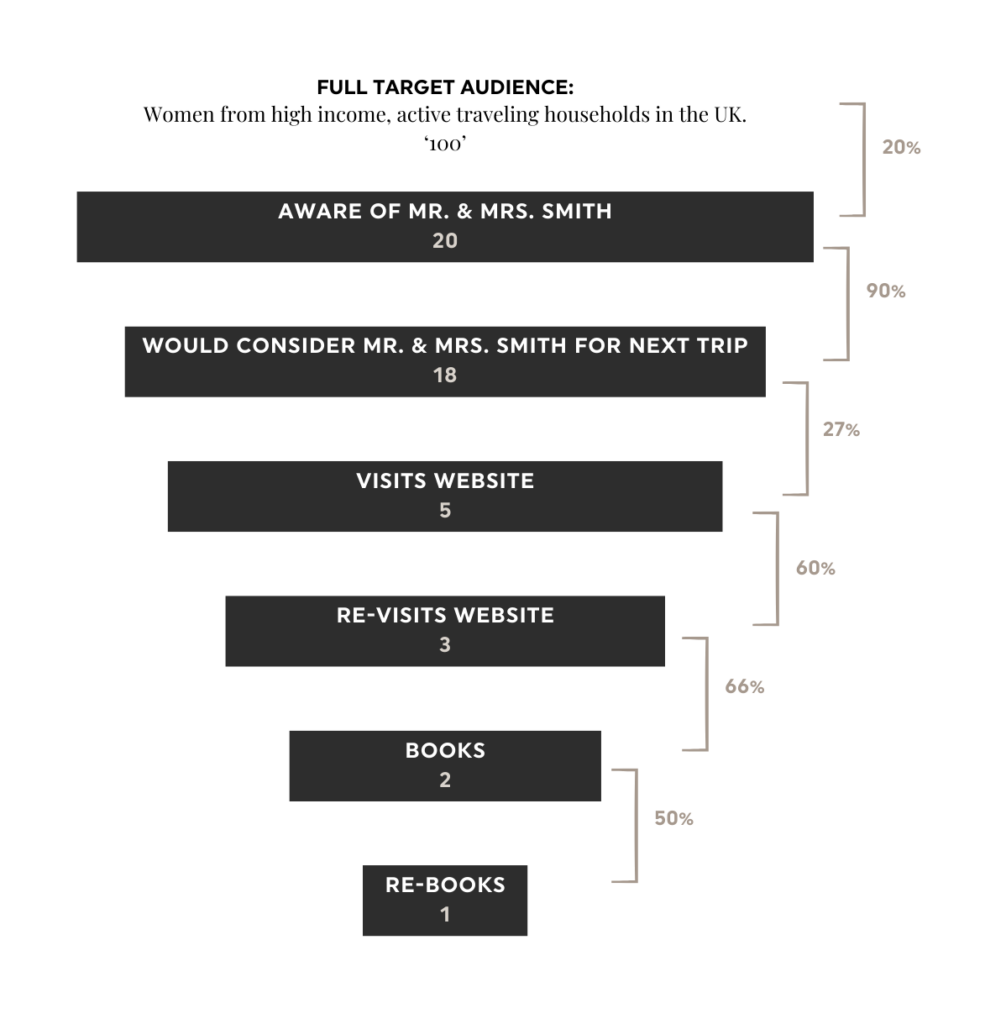If there’s one thing that I see over and over again, it’s marketing tactics that are not rooted in marketing strategy. Going straight to tactics without the objective – without the strategic underpinning – is the fastest way to customer confused and wasted budget. We don’t always learn how to set effective marketing objectives that form the thread and focus throughout all the tactics.
So what is actually at the core of marketing strategy? How do you link tactics with purpose and intention?
There are three elements – the pillars – the cornerstones – the swords I’ll die on (too much?!) that are the core of any good marketing strategy: objectives and their corresponding strategic approaches and KPIs.

I talk about this some more in my KPI blog post, contextualising the KPIs that you measure. We’re going to go back to the beginning on this post, focusing on the objectives which are the basis and beginnings of your marketing strategy.
First thing, let’s get deeper into what an objective is. An objective is a specific, measurable goal that guides marketing activities It’s the “what” you’re trying to achieve through your marketing efforts—whether that’s increasing brand awareness, generating leads, improving customer retention, or driving sales.
It’s also key to distinguish between business objectives and marketing objectives. When it comes to business objectives (or simply, goals), most founders and marketing leaders have a crystal-clear vision:
Sales! Revenue! Profit!
“Hit £1M in revenue this year” or “Expand into Germany by next quarter” .
But when it’s time to translate those ambitions into actionable marketing objectives, things can get… murky.
That’s because too often, we confuse corporate objectives (the company’s cross-department and ultimate goals) with marketing objectives (the marketing goals that will help us achieve the corporate objectives).
They’re both goals, but there’s a hierarchy among them.
Corporate Objectives vs. Marketing Objectives
Corporate objectives answer the question: What are we trying to achieve as a business? They’re broad, high-level, and usually tied to revenue, market share, or expansion goals.
Examples include:
- Generate £1M in revenue by year-end
- Expand into Germany by Q4
- Increase market share this year by 10%
Great corporate objectives set the tone, but they don’t tell your marketing team what facet of that goal is their responsibility – what they need to do in order to get the business to that goal. That’s where marketing objectives step in.
Marketing objectives are smaller, specific goals designed to influence customer behaviour in a way that supports the big picture. For example:
- If the company wants to expand into Germany, marketing may need to increase brand awareness in Germany by 25% in six months
- If the company wants to generate £1M in revenue by year-end, marketing may need to drive 2,000 website visitors from paid campaigns this quarter
- If the company wants to Improve conversion rates on product pages by 15%
The magic is in the relationship between the two. Corporate objectives show you the ultimate destination; marketing objectives provide the marketing milestones to get there.
A good sense-check:
When you’re reviewing your objectives, ask yourself who’s required in order to achieve the goal. Avoid the pitfall of making it more specific, but still responsibility-agnostic. An objective for the Germany expansion above often becomes “Secure 500 customers in the first 6 months”. But that’s not something your marketing team can directly and solely control.
Always ask yourself, ‘Does this objective go beyond marketing?’ Does it venture into the product realm of responsibility? Or sales? Could the same objective be achieved by other teams? That’s when you know you need to hone in on the marketing angle of that objective.
Using the Customer Journey to Determine Effective Marketing Objectives
Let’s dig into the revenue objective a little more.
We know the corporate objective is to hit £1M in revenue this year. A natural instinct might be to focus on things like “secure 500 new customers”. But that’s still not specific enough to truly focus marketing activity.
To decide where you need to hone in, turn to the customer journey. Break down the behaviours and the journey customers go on to ultimately achieve this goal.
Ask yourself:
- Do a sufficient amount of your target market know you exist?
- Are they finding your website but not reaching out?
- Are demo requests turning into sales?
Each of these questions points contribute to the ultimate revenue goal but point to a different stage in your customer journey—and the answers help shape your marketing objectives and provide your focus.
Imagine a leaking pipe that has holes all throughout it. You’re losing water at an alarming rate, but there are some holes that are bigger than others. You need to assess which holes are most causing the lost leakage, knowing where to focus your efforts first and foremost.

You will lose customers at each part of the customer journey, but where are you losing the most? What is the biggest drop-off? Where are you underperforming as compared to your competitors or the industry average?
This what your funnel will tell you.
Here’s a hypothetical example of a customer journey for a luxury travel company, Mr. & Mrs. Smith:

Steps to creating your customer journey:
List all the steps your customer goes through to find you/buy from you
And crucially, base the journey on their behaviour, not only on your content or channels.
This funnel follows the customer, first and foremost. We often write customer journeys like we exist at the dawn of time, the creators of heaven and Earth 🌍 🤣. We’re used to plugging our content into the rigid categories of ‘awareness’, ‘consideration’, etc., only thinking about their awareness, consideration, etc., of us. But as we think through the lens of our customer, let’s reflect their realistic journey and factor in their actual behaviours, not just their behaviours that pertain to us. The first point of the journey is likely not interaction with you. What’s happening in their headspace before this? That’s where you want to start.
Once you’ve mapped your customer journey, apply the numbers.
You’ll have the full audience size at the top of the funnel (100% of the audience.). Then as you proceed through the journey, apply the percentage of people who make it to that stage. Always think about it in terms of percentage of the total audience:
- E.g. what percentage of the audience are aware of you?
- How many would consider you?
- How many would visit your website?
- And so on.
Then, you calculate the conversion stats.
You may have established that 15% of the audience are aware of you, and 9% would consider you. Granted, at face value, only having 10% of the audience’s consideration feels low. But, the conversion from being aware to considering you, (=10/15), sits at 66%. That’s not terrible. Comparatively, you see above that only 15% of the whole market is aware of you, that 66% is put into context.
This step is crucial to seeing the true performance of each stage.
You can get this information from two sources:
- Your research. Surveys are your best bet here – using a representative sample (use this calculator to determine what that number is!), you can figure out how many are aware of you, considering you (or your competitors, etc.).
- Your own stats: Then, you’ll reach a point of the journey where your own conversion stats will tell the story. Your website visitors vs. conversions, your number of customers, etc.
Turn your journey into effective marketing objectives:
With all of this information to hand, you can analyse the journey to determine your objectives.
Identify the problem areas
Looking at your conversion stats, what really needs attention? Where are your customers falling off the journey? Are you driving plenty of traffic to your website, but they’re not signing up for your newsletter? Or maybe your sales team is getting leads, but they’re poorly qualified? Understanding where the friction points are will give you clarity on where your marketing objectives should focus.
You can’t focus on every stage of the customer journey – that’s like having no objective at all. Look at where the biggest point of impact can be made. Going back to the leaking pipe analogy, what is the biggest hole you can plug? With that sorted, you’ll be able to move onto the next point of impact.
Key Ingredients for an Effective Strong Marketing Objective
No lesson on objectives is complete without the rule we all know and love, or maybe love to hate: the S.M.A.R.T. rule.
But truly, objectives without these attributes lack the direction and specificity that motivates and supports a marketing team.
Let’s recap – a solid marketing objective should be:
- Specific
- Avoid vague goals like “generate more leads”. Instead, say: “Generate 500 leads from paid campaigns by the end of Q1.”
- Measurable
- You need a clear way to track success. Are you using web traffic, email signups, or lead quality as your metric? Pick one and stick with it. What’s your current benchmark? What’s your target?
- Ambitious
- Your objectives need to be punchy – gathering your team together towards a goal that will be worthy of celebration.
- Realistic
- Yet keeping the balance, this is the counterpart to ‘ambitious’, above. This needs to be a stretch but within the realm of reason, otherwise motivation and commitment goes out the window.
- Time-bound
- We need to know our timeframe. A deadline creates urgency. It’s the difference between “improve conversion rates” and “improve conversion rates by 10% in Q4.”
Let’s go back to our example above – the corporate objective was to hit £1M in revenue. You’ve plotted the customer journey and realise that once your potential leads reach your website, your conversion rates are quite strong. You’ve realised that you simply need more people to be aware of you.
Your objective could look like this:

And there you have it. Strategic marketing objectives that reflect your full customer journey and show the stages where you can have the greatest impact. Focus your time, budget and team on what will move the needle.
Some key takeaways:

So, what’s your next big marketing objective? Let me know in the comments.
And if you need support in determining your effective marketing objectives and embedding them as the cornerstone of your marketing strategy, just get in touch. We would be happy to help!

+ show Comments
- Hide Comments
COMMENT